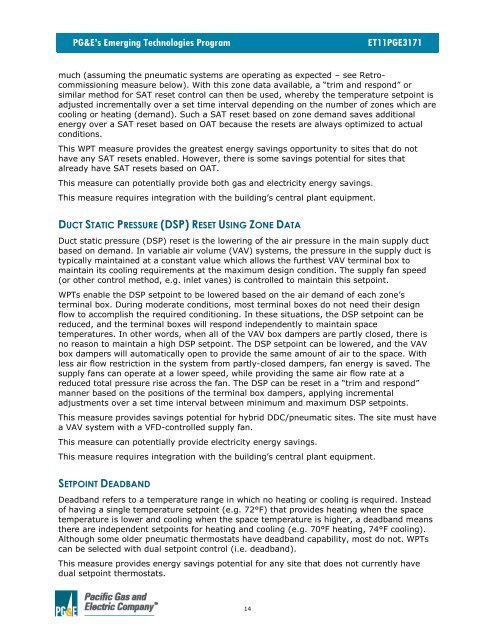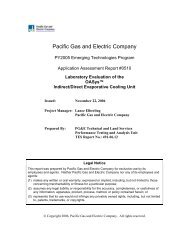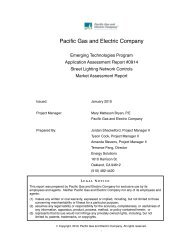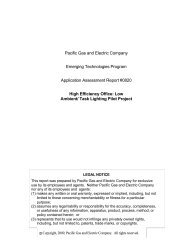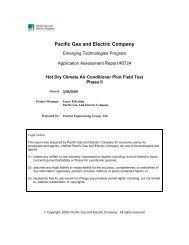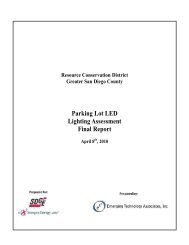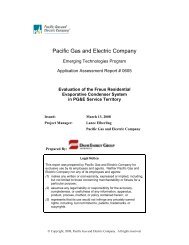PGE Wireless Pneumatic Thermostat ET Final Report.pdf
PGE Wireless Pneumatic Thermostat ET Final Report.pdf
PGE Wireless Pneumatic Thermostat ET Final Report.pdf
You also want an ePaper? Increase the reach of your titles
YUMPU automatically turns print PDFs into web optimized ePapers that Google loves.
PG&E’s Emerging Technologies Program <strong>ET</strong>11<strong>PGE</strong>3171<br />
much (assuming the pneumatic systems are operating as expected – see Retrocommissioning<br />
measure below). With this zone data available, a “trim and respond” or<br />
similar method for SAT reset control can then be used, whereby the temperature setpoint is<br />
adjusted incrementally over a set time interval depending on the number of zones which are<br />
cooling or heating (demand). Such a SAT reset based on zone demand saves additional<br />
energy over a SAT reset based on OAT because the resets are always optimized to actual<br />
conditions.<br />
This WPT measure provides the greatest energy savings opportunity to sites that do not<br />
have any SAT resets enabled. However, there is some savings potential for sites that<br />
already have SAT resets based on OAT.<br />
This measure can potentially provide both gas and electricity energy savings.<br />
This measure requires integration with the building’s central plant equipment.<br />
DUCT STATIC PRESSURE (DSP) RES<strong>ET</strong> USING ZONE DATA<br />
Duct static pressure (DSP) reset is the lowering of the air pressure in the main supply duct<br />
based on demand. In variable air volume (VAV) systems, the pressure in the supply duct is<br />
typically maintained at a constant value which allows the furthest VAV terminal box to<br />
maintain its cooling requirements at the maximum design condition. The supply fan speed<br />
(or other control method, e.g. inlet vanes) is controlled to maintain this setpoint.<br />
WPTs enable the DSP setpoint to be lowered based on the air demand of each zone’s<br />
terminal box. During moderate conditions, most terminal boxes do not need their design<br />
flow to accomplish the required conditioning. In these situations, the DSP setpoint can be<br />
reduced, and the terminal boxes will respond independently to maintain space<br />
temperatures. In other words, when all of the VAV box dampers are partly closed, there is<br />
no reason to maintain a high DSP setpoint. The DSP setpoint can be lowered, and the VAV<br />
box dampers will automatically open to provide the same amount of air to the space. With<br />
less air flow restriction in the system from partly-closed dampers, fan energy is saved. The<br />
supply fans can operate at a lower speed, while providing the same air flow rate at a<br />
reduced total pressure rise across the fan. The DSP can be reset in a “trim and respond”<br />
manner based on the positions of the terminal box dampers, applying incremental<br />
adjustments over a set time interval between minimum and maximum DSP setpoints.<br />
This measure provides savings potential for hybrid DDC/pneumatic sites. The site must have<br />
a VAV system with a VFD-controlled supply fan.<br />
This measure can potentially provide electricity energy savings.<br />
This measure requires integration with the building’s central plant equipment.<br />
S<strong>ET</strong>POINT DEADBAND<br />
Deadband refers to a temperature range in which no heating or cooling is required. Instead<br />
of having a single temperature setpoint (e.g. 72°F) that provides heating when the space<br />
temperature is lower and cooling when the space temperature is higher, a deadband means<br />
there are independent setpoints for heating and cooling (e.g. 70°F heating, 74°F cooling).<br />
Although some older pneumatic thermostats have deadband capability, most do not. WPTs<br />
can be selected with dual setpoint control (i.e. deadband).<br />
This measure provides energy savings potential for any site that does not currently have<br />
dual setpoint thermostats.<br />
14


